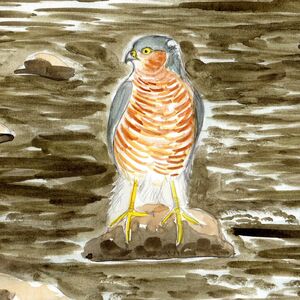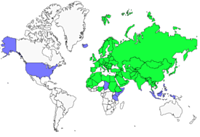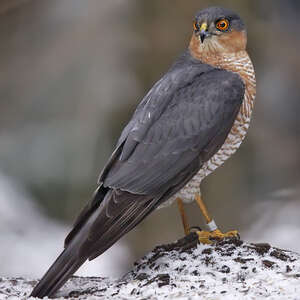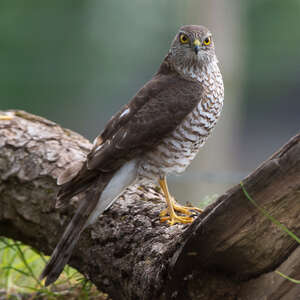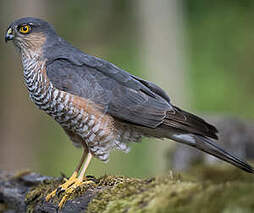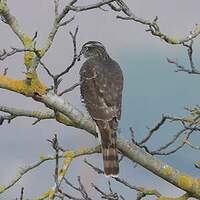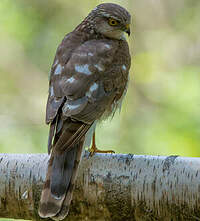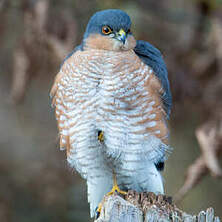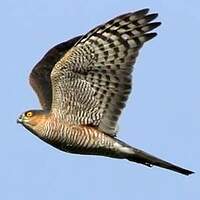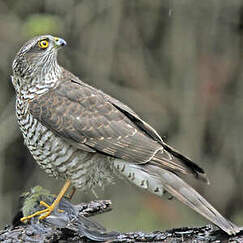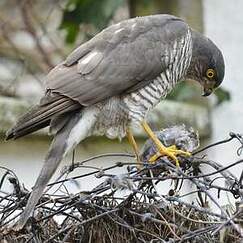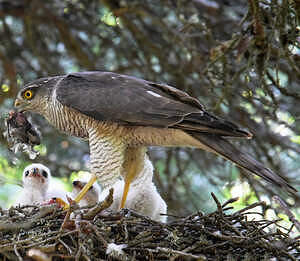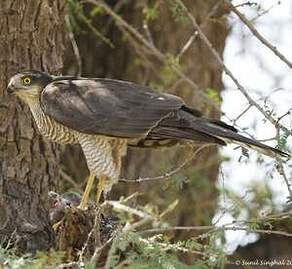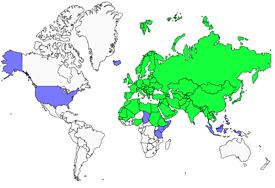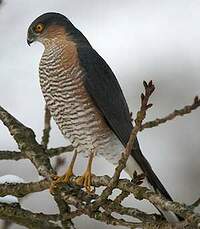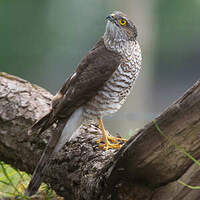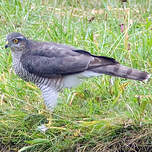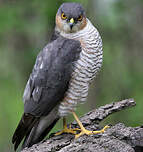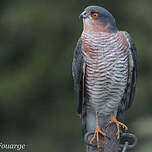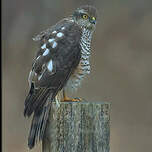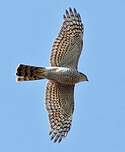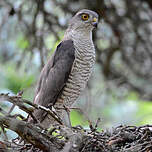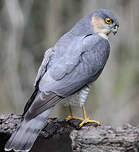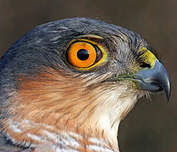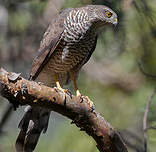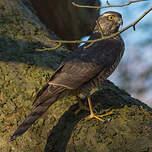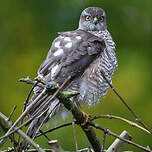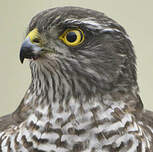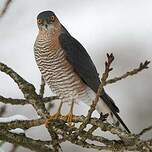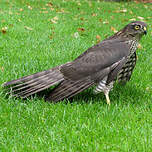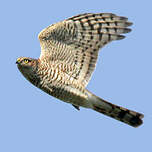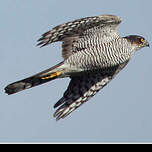Eurasian Sparrowhawk
Accipiter nisus - Épervier d'Europe
Identification
The Eurasian Sparrowhawk is a small Accipiter, roughly the size of a pigeon. It has a larger, stronger cousin, the Eurasian Hobby, with whom identification can be confused unless one notices the size difference. They both share the accipiter silhouette, characterized by wide, short, round-tipped wings and a long tail, yellow eyes, and finely barred underparts in adults. Appreciating size is therefore fundamental. The Sparrowhawk has a long, thin tail, cut square-end (shorter, wider and round-tip for the Hobby). If one assigns a value of 1 to the width of its wing, the length of its tail will be around 1.3 (1.08 to 1.1 for the Hobby).
There is sexual dimorphism in the Sparrowhawk. Adult male is typical with its slate-gray upperparts and red patches on the cheeks, flanks and barring of the underparts. Iris is orange. Adult female, noticeably larger, is brownish-gray to gray-brown above, and barred brown below. Iris is yellow and she usually has a pale eyebrow. She can be confused with the Hobby. The juvenile resembles female but its upperwing coverts are edged red and its underparts more coarsely barred.
At rest, the long, slender tarsi of the Sparrowhawk are diagnostic. In flight, its rapid, clipped and jerky wing beats are distinctive. The adult Hobby has no red, a distinct pale eyebrow, more finely barred gray-brown underparts, broad chest, strong tarsi, broader at base and with round-end tail. Its wing beats are slower.
Finally, a trick! When seen from underneath, an adult in flight has to be watched for their secondaries.These are clearly barred with brown on the Eurasian Sparrowhawk while the bars are more faded and less visible on the Common Buzzard. Helpful on photos.
Subspecific information 7 subspecies
- Accipiter nisus nisus (Europe to sw Siberia and c Asia)
- Accipiter nisus nisosimilis (nw Siberia to n China and Japan)
- Accipiter nisus dementjevi (Pamir-Alai to Tien Shan Mts. c Asia.)
- Accipiter nisus melaschistos (e Afghanistan to sw China)
- Accipiter nisus wolterstorffi (Corsica and Sardinia)
- Accipiter nisus punicus (nw Africa)
- Accipiter nisus granti (Madeira and Canary Is.)
Foreign names
- Épervier d'Europe,
- Gavilán común,
- gavião-eurasiático,
- Sperber,
- karvaly,
- Sperwer,
- Sparviere,
- sparvhök,
- Spurvehauk,
- jastrab krahulec,
- krahujec obecný,
- Spurvehøg,
- varpushaukka,
- esparver comú,
- Sparrhaukur,
- krogulec (zwyczajny),
- zvirbuļu vanags,
- skobec,
- Перепелятник,
- ハイタカ,
- 雀鹰,
- เหยี่ยวนกกระจอกใหญ่,
- 北雀鷹〔雀鷹〕,
Voice song and cries
Eurasian Sparrowhawks are very discreet if not silent during winter. Their calls are often heard close to the nest during the breeding season. At that time of the year, they emit series of kiou kiou kiou whose speed mainly depend on its purpose. The rhythm of the calls is indeed very different depending on its use during display flights, as alarm call or to announce the return to the nest with a prey. The female's begging call is a plaintive hui-ou.
Habitat
During the breeding season, the Eurasian Sparrowhawk prefers areas that alternate between open spaces and coniferous and deciduous woodlands.
Behaviour character trait
When hunting, Eurasian Sparrowhawks want to take advantage of the element of surprise. To do this, they fly low to the ground at very low heights, often taking shelter in hedgerows, bushes or buildings to hide and then conduct a lightning quick, sudden attack on flocks of small birds that feed in open spaces.
When possible prey is hidden in foliage, the sparrowhawks attempt to flush them out by striking the branches, but this strategy is often unsuccessful and in such cases, less than 5% of the attempts are successful. Nevertheless, sparrowhawks are very stubborn hunters, they pursue their prey for long periods of time, sometimes at high altitudes. When they have missed, they follow them into hedges and woods, finishing the chase running feet in the thickets if necessary. They are able to show opportunism and patience, watching feeders in gardens to surprise blue tits that come to eat.In the spring, it happens that the pair undertakes rapidly undulating flights, so quickly that at the base of each dive, the sparrowhawk appears to rebound on an invisible surface. It also undertakes fast dives, with its head forward and wings completely closed. These rituals are often accompanied by a high-pitched cackling.
Flight
Dietfeeding habits
Intensive research conducted in Denmark on over 60,000 prey animals led to a fairly accurate composition of the menu of the Eurasian Sparrowhawk.
During the breeding season, nearly 98% of the diet consists of small birds. In detail, the meal is composed as follows: 13% thrushes and Turdidae, 11% House Sparrows, 8% warblers and species from the Sylviidae family, 9% tits, 7% Tree Sparrows and larks, 6% swallows, 5% Chaffinches, 4% starlings and 3% pipits. In total, more than 150 species have been identified. Dove, gallinaceous and small pheasants represent a fairly negligible amount, under 1%.During the winter period, the capture of prey remains substantially the same. The distribution is somewhat different due to the migration of some species that fly south. House Sparrows then peak up to 20%. Small mammals such as mice and shrews make up part of the food during this period. In years of rodent proliferation, they can represent up to 15% of the total diet, especially in northern areas. The sparrowhawks, exclusively the females, are not afraid to attack pheasants but as they grow, they become too large a prey to be caught.
Because of their larger size, females hunt for heavier prey such as thrushes and Wood Pigeons. This difference allows couples to occupy smaller territories without competition between the partners for food.
Reproduction nesting
Eurasian Sparrowhawks usually reach sexual maturity between the ages of one and two years. Most of the time relationship bonds do not exceed one breeding season.
However, in regions where the birds of prey are sedentary or do not move far from their breeding sites, the bonds can last and persist for several consecutive years. Rare cases of polygamy and polyandry have sometimes been observed. At the beginning of the season, some couples, but apparently not all, perform ritual flights above the nest. In Denmark, where the species is quite widespread, these birds nest in spruce forests. The nest, which is renewed every year, is built at the transition between dead branches and healthy branches, at a height that varies from 5 to 8 meters. In our western European countries, a single conifer is often enough. Both partners join forces to build the structure, however the female does most of the work. The latter is almost entirely made with loosely assembled dead twigs and twine. The shallow cup is lined with evergreen needles and bark to which a few feathers from the moult are added. The clutch usually consists of 4 to 6 eggs. These are laid from the beginning of May or in June, with an interval of 2 days between each egg. Each egg is incubated on average for 33 to 35 days, but given the staggered laying, incubation can last up to 42 days in total. The chicks remain in the nest for 24 to 30 days but, after the flight, they are still dependent on their parents for 3 to 4 weeks.Geographic range
As their name suggests, the Eurasian Sparrowhawks are present throughout the whole Old Continent, from the Iberian peninsula up to the Scandinavian countries and Russia. Their distribution encompasses an expansiver belt until the Pacific Ocean, with a separate enclave at the Himalayas. On this vast territory are officially recognized six different subspecies: A. n. nisus, the nominal race (western, central and northern Europe) - A. n. nisosimilis (eastern Europe, Siberia) - A. n. melanoschistos (Himalaya, Indian subcontinent) - A. n. wolterstorffi (Corsica and Sardinia) - A. n. granti (Canary Islands and Madeiras) - A. n. punicus (Northern Africa, from Morocco to Tunisia).
In the northern parts of their distribution range, these birds are migratory. All Scandinavian populations migrate towards the south from mid-August. Out of the 17.000 individuals who cross the Baltic Sea, only a rather small number passes the Straits of Mediterranean to get to Africa. Most of the birds settle in the southern parts of Europe, where they join resident populations throughout the whole year. About 1.000 birds pass Gibraltar and 500 pass the Bosphore Strait, sometimes even reaching the equator in the south. An analysis of the ringed birds shows that juvenile birds outnumber adults amongst the migrants. Females, which are more powerfully built, are more resistant to the harsher climatic conditions and thus migrate later. The journey of migration is very long, involving hundreds of kilometres. The specimens studied in Spain often come from Sweden, Finland and Czechoslovakia.
Threats - protection
IUCN conservation status
concern
in the Wild
threatened
evaluated
In the 1950s and 1960s, with the emergence of new products such as DDT to protect crops from insects, the Eurasian Sparrowhawk faced a very difficult period. The failure of broods due to thinning eggshells rose in some regions to over 30%. The cessation of these products and the introduction of more modern and ecological measures allowed the sparrowhawks to recolonize a part of the lost territories. We cannot be overly optimistic however. In many regions, there are not enough prey to allow for a real increase. In some countries such as Scandinavian countries, Greece, the Czech Republic or Slovakia, shooting this raptor is not really forbidden. According to Gensbol, the European population can be estimated at between 90,000 and 125,000 breeding pairs, making the species minor concern. The population of Madeira and the Canaries is reduced to 100 and 200 pairs respectively due to the significant degradation of their habitat.
Sources of information
- IOC World Bird List (v14.1), Gill, F and D Donsker (Eds). 2024-04-18.
Other sources of interest
 Specification sheet created on
28/10/2023 by Daniel Le-Dantec
Specification sheet created on
28/10/2023 by Daniel Le-Dantec partially rewritten on 00/00/0000 by Jean François
Translation by AI Oiseaux.net
published: 22-01-2011 - Updated: 29-01-2021
© 1996-2024 Oiseaux.net
- Accipitriformes
- Aegotheliformes
- Anseriformes
- Apodiformes
- Apterygiformes
- Bucerotiformes
- Caprimulgiformes
- Cariamiformes
- Casuariiformes
- Charadriiformes
- Ciconiiformes
- Coliiformes
- Columbiformes
- Coraciiformes
- Cuculiformes
- Eurypygiformes
- Falconiformes
- Galliformes
- Gaviiformes
- Gruiformes
- Leptosomiformes
- Mesitornithiformes
- Musophagiformes
- Nyctibiiformes
- Opisthocomiformes
- Otidiformes
- Passeriformes
- Pelecaniformes
- Phaethontiformes
- Phoenicopteriformes
- Piciformes
- Podargiformes
- Podicipediformes
- Procellariiformes
- Psittaciformes
- Pterocliformes
- Rheiformes
- Sphenisciformes
- Steatornithiformes
- Strigiformes
- Struthioniformes
- Suliformes
- Tinamiformes
- Trogoniformes

